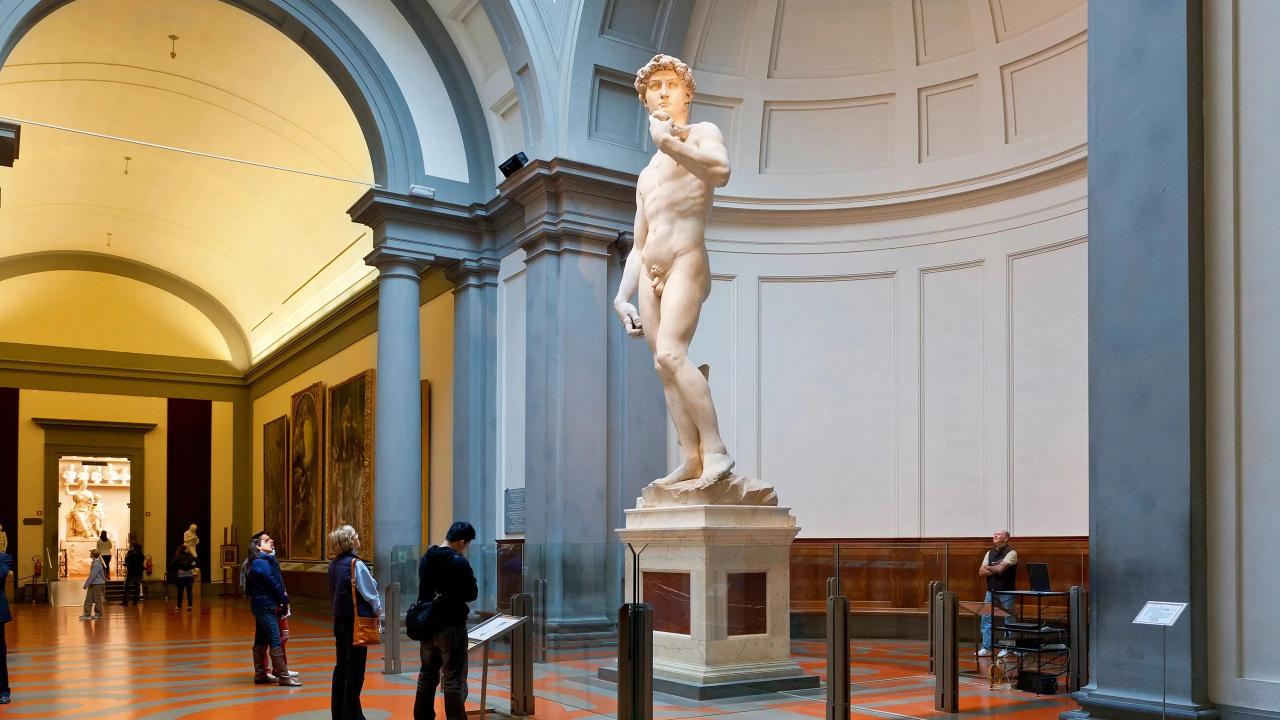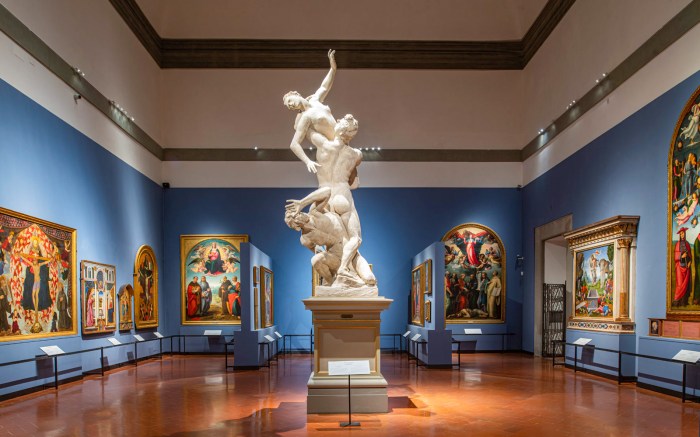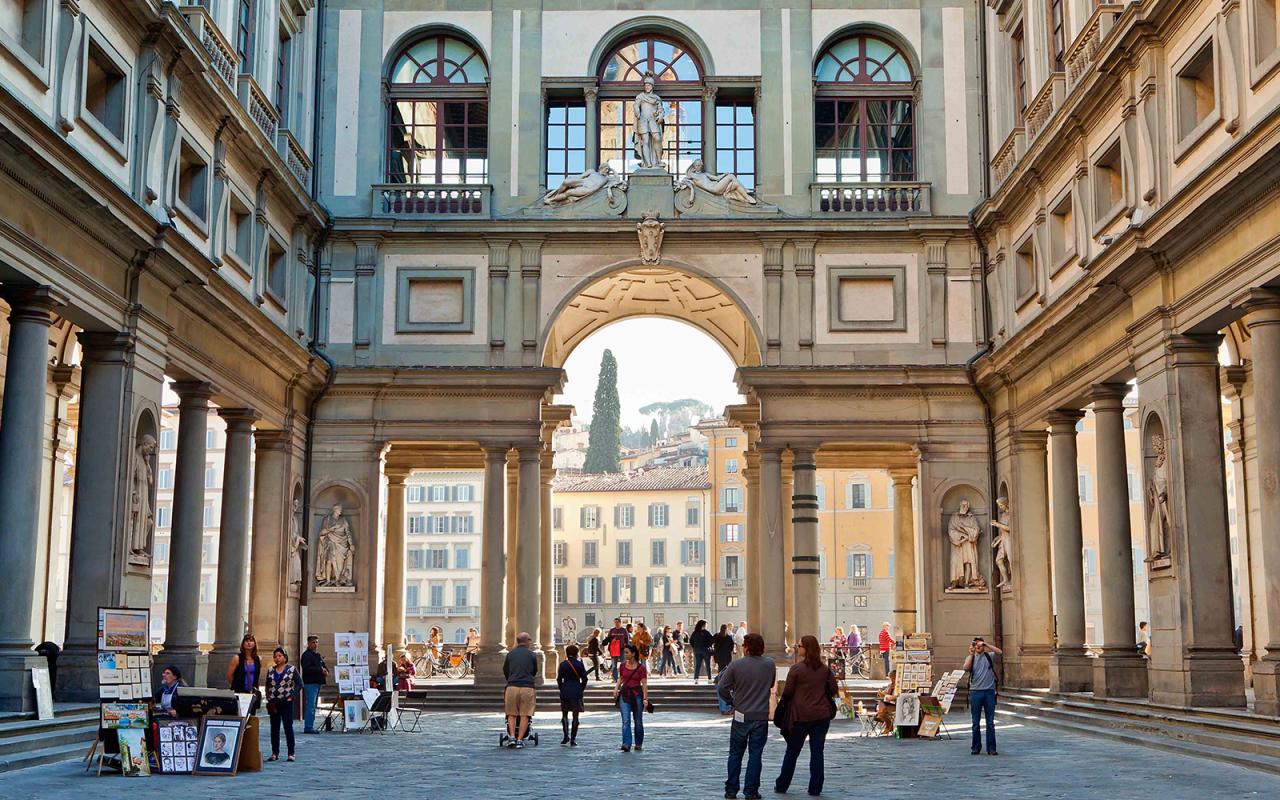Embark on an extraordinary journey through the hallowed halls of the Accademia Gallery, a sanctuary of artistic wonders that has captivated art enthusiasts for centuries. Nestled in the heart of Florence, this iconic institution houses an unparalleled collection of masterpieces that illuminate the evolution of art from the Renaissance to the Baroque era.
Within these hallowed walls, visitors are transported to a realm where Michelangelo’s David stands tall, his marble form radiating both power and vulnerability. The gallery’s collection extends far beyond this iconic sculpture, showcasing the genius of Botticelli, Ghirlandaio, and many other artistic luminaries.
Overview of Accademia Gallery

Nestled in the heart of Florence, the Accademia Gallery is a sanctuary of art and a testament to the creative genius of the Italian Renaissance. Established in 1784 by the Grand Duke of Tuscany, Peter Leopold, its primary purpose was to provide a space for the training and education of young artists.
Over the centuries, the gallery has evolved into a renowned museum, housing an extraordinary collection of paintings, sculptures, and drawings. Its architectural design, characterized by neoclassical elements and a harmonious blend of natural light and shadow, creates an awe-inspiring setting for the masterpieces within.
The Accademia Gallery, home to Michelangelo’s David, is a must-visit destination in Florence. After exploring the gallery, consider a trip to the picturesque town of Alcudia on the island of Mallorca. Alcudia boasts stunning beaches, charming streets, and ancient ruins.
Upon your return to Florence, revisit the Accademia Gallery to delve deeper into the works of the Renaissance masters.
Significance and Role
The Accademia Gallery plays a pivotal role in preserving and promoting the legacy of Italian art. It is home to Michelangelo’s iconic statue of David, one of the most recognizable and celebrated works of art in the world. The gallery also houses a significant collection of paintings by Florentine masters such as Botticelli, Ghirlandaio, and Pontormo.
Through its exhibitions, educational programs, and conservation efforts, the Accademia Gallery serves as a vital center for the appreciation and understanding of art history. It fosters a deeper connection between the public and the artistic treasures that have shaped the cultural heritage of Florence and beyond.
Notable Collections and Exhibits
The Accademia Gallery boasts an exceptional collection of masterpieces spanning various artistic periods, with a particular focus on Florentine art from the 13th to the 16th centuries. The gallery’s holdings include paintings, sculptures, drawings, and other works by renowned artists, offering visitors a comprehensive overview of the development of Florentine art.
The Accademia Gallery in Florence, Italy is home to some of the world’s most famous Renaissance art, including Michelangelo’s David. For a different cultural experience, consider visiting Almaty , Kazakhstan’s largest city. Almaty offers a blend of modern architecture and traditional Central Asian culture.
After exploring Almaty, return to the Accademia Gallery to admire the masterpieces of the Italian Renaissance.
Among the most notable collections and exhibits at the Accademia Gallery are:
Paintings
The gallery houses a significant collection of paintings by Florentine masters, including:
- Sandro Botticelli’s Birth of Venus and Primavera: These iconic works exemplify the grace and beauty of the Early Renaissance period, depicting mythological scenes with delicate brushwork and vibrant colors.
- Domenico Ghirlandaio’s Adoration of the Magi: This large-scale painting showcases the artist’s mastery of perspective and realism, depicting a crowded scene with intricate details.
- Filippo Lippi’s Annunciation: This charming painting depicts the Virgin Mary receiving the message of the angel Gabriel, with a gentle and intimate atmosphere.
Sculptures
The Accademia Gallery is renowned for its extensive collection of sculptures, including:
- Michelangelo’s David: This iconic masterpiece is considered one of the greatest works of art in history, depicting the biblical hero David with unparalleled anatomical precision and emotional intensity.
- Giambologna’s Rape of the Sabine Women: This dynamic and expressive sculpture captures the moment of violence and chaos during the abduction of Sabine women by Roman soldiers.
- Bartolomeo Bandinelli’s Hercules and Cacus: This powerful sculpture depicts the hero Hercules battling the giant Cacus, showcasing the artist’s skill in portraying movement and tension.
Drawings
The gallery also houses a valuable collection of drawings, including:
- Leonardo da Vinci’s Vitruvian Man: This iconic drawing explores the ideal proportions of the human body, demonstrating Leonardo’s scientific and artistic genius.
- Michelangelo’s Studies for the Battle of Cascina: These preparatory drawings for a lost fresco depict muscular and dynamic figures engaged in battle.
- Raphael’s Head of a Young Woman: This delicate drawing captures the beauty and grace of a young woman, showcasing Raphael’s mastery of line and form.
| Collection | Featured Artists | Key Works | Significance |
|---|---|---|---|
| Paintings | Botticelli, Ghirlandaio, Lippi | Birth of Venus, Adoration of the Magi, Annunciation | Exemplifies the grace and beauty of the Early Renaissance |
| Sculptures | Michelangelo, Giambologna, Bandinelli | David, Rape of the Sabine Women, Hercules and Cacus | Renowned for their anatomical precision and emotional intensity |
| Drawings | Leonardo da Vinci, Michelangelo, Raphael | Vitruvian Man, Studies for the Battle of Cascina, Head of a Young Woman | Demonstrates the artists’ scientific and artistic genius |
Artistic Movements and Influences

The Accademia Gallery is a treasure trove of artistic masterpieces spanning various artistic movements. The gallery’s collection showcases the evolution of art from the Renaissance to the Baroque period, with each movement leaving its unique imprint on the works.
Renaissance Art
The Renaissance, marked by a revival of classical ideals and humanism, had a profound impact on the art of the Accademia Gallery. Artists like Botticelli, Leonardo da Vinci, and Michelangelo embraced the principles of perspective, naturalism, and emotional expression. The result was a departure from the stylized forms of the Middle Ages towards a more realistic and humanistic portrayal of the world.
For art enthusiasts, a visit to the Accademia Gallery is a must. Immerse yourself in the beauty of Michelangelo’s David and other masterpieces. To plan your perfect itinerary, consider using a travel itinerary template. It will help you organize your time and ensure you don’t miss any highlights of the Accademia Gallery.
- Venus and Mars by Botticelli: Depicts the Roman gods in a serene and idyllic setting, embodying the Renaissance’s fascination with classical mythology.
- Madonna of the Bruges by Michelangelo: A marble sculpture showcasing the artist’s mastery of anatomy and emotional depth.
Mannerist Art
Mannerism, a transitional period between the Renaissance and Baroque, emerged in the mid-16th century. It was characterized by elongated figures, artificial poses, and an emphasis on intellectual complexity. The Accademia Gallery houses notable works by Mannerist artists such as Pontormo and Bronzino.
- Deposition by Pontormo: A dynamic and emotionally charged painting depicting the descent of Christ from the cross.
- Venus, Cupid, Folly, and Time by Bronzino: A complex allegory that explores the themes of love, beauty, and the passage of time.
Baroque Art
The Baroque period, characterized by its exuberance, drama, and grandeur, found expression in the works of artists like Caravaggio, Artemisia Gentileschi, and Bernini. The Accademia Gallery features stunning examples of Baroque art, showcasing the use of chiaroscuro, emotional intensity, and dynamic compositions.
- Judith Beheading Holofernes by Artemisia Gentileschi: A powerful depiction of a biblical heroine’s triumph over evil.
- Ecstasy of Saint Teresa by Bernini: A marble sculpture capturing the mystical experience of a saint, embodying the Baroque’s emotional and theatrical qualities.
Educational and Cultural Impact

The Accademia Gallery has played a pivotal role in fostering an appreciation for art and artistic history. Its extensive collection of masterpieces provides an immersive experience that educates visitors about the evolution of Western art, from the Middle Ages to the Renaissance. The gallery’s chronological arrangement allows visitors to trace the development of artistic techniques and styles, gaining a deeper understanding of the historical context in which these works were created.
Educational Programs and Outreach Initiatives
The gallery offers a comprehensive range of educational programs, workshops, and outreach initiatives tailored to diverse audiences. These programs include guided tours, lectures, and hands-on workshops designed to engage students, art enthusiasts, and the general public. The gallery’s educational team works closely with schools and universities to develop curriculum-aligned programs that enhance students’ learning experiences.
Contribution to the Cultural Fabric, Accademia gallery
The Accademia Gallery is an integral part of Florence’s cultural landscape. It attracts visitors from around the world, contributing to the city’s tourism industry and economic vitality. The gallery also collaborates with other cultural institutions in Florence, organizing joint exhibitions and events that showcase the city’s rich artistic heritage. Through its educational programs and outreach initiatives, the gallery plays a vital role in fostering a vibrant and informed art community, both locally and internationally.
Restoration and Preservation Efforts: Accademia Gallery

The Accademia Gallery is committed to preserving and restoring its invaluable collection for future generations. The gallery has a dedicated team of conservators who work tirelessly to ensure the artworks remain in pristine condition.
Challenges and Techniques
Restoring and preserving artworks is a complex and challenging task. The conservators must consider the age, condition, and materials used in each piece. They use a variety of techniques, including cleaning, retouching, and structural repairs, to restore the artworks to their former glory.
Case Studies
One of the most successful restoration projects undertaken at the Accademia Gallery was the restoration of Michelangelo’s “David.” The sculpture had been damaged over the centuries by pollution, weathering, and vandalism. The conservators used a combination of laser cleaning, chemical treatments, and structural repairs to restore the sculpture to its original condition.
Importance of Conservation
The conservation efforts at the Accademia Gallery are essential to ensuring the longevity and accessibility of its collections. By preserving and restoring the artworks, the gallery ensures that they can be enjoyed by generations to come.
Tourism and Visitor Experience
The Accademia Gallery attracts a large number of tourists and visitors annually, owing to its renowned collection of masterpieces. Its popularity stems from the iconic works of Michelangelo, particularly the “David” sculpture, which draws art enthusiasts from around the world.
Target Audience
The gallery primarily caters to art lovers, history buffs, and tourists interested in Renaissance art. Its diverse collection also appeals to students, researchers, and individuals seeking cultural enrichment.
Closing Notes

As we bid farewell to the Accademia Gallery, its legacy as a beacon of artistic excellence continues to shine brightly. Through its exceptional collection, restoration efforts, and educational initiatives, the gallery has not only preserved a priceless heritage but has also ignited a passion for art in countless hearts. Its doors remain open, inviting us to return time and again to marvel at the enduring power of human creativity.
FAQ Overview
What are the highlights of the Accademia Gallery’s collection?
The gallery is renowned for housing Michelangelo’s David, one of the most iconic sculptures in art history. Other highlights include Botticelli’s Madonna of the Sea and Ghirlandaio’s Adoration of the Magi.
What is the history behind the Accademia Gallery?
The gallery was founded in 1784 by the Grand Duke of Tuscany, Pietro Leopoldo. It was originally intended to house the works of the Accademia di Belle Arti, an art school established in 1563.
What restoration efforts have been undertaken at the Accademia Gallery?
The gallery has undertaken extensive restoration efforts over the years, including the cleaning and conservation of Michelangelo’s David. These efforts have helped to preserve the artwork for future generations.
What educational programs does the Accademia Gallery offer?
The gallery offers a variety of educational programs, including guided tours, workshops, and lectures. These programs are designed to engage visitors of all ages with the art on display.